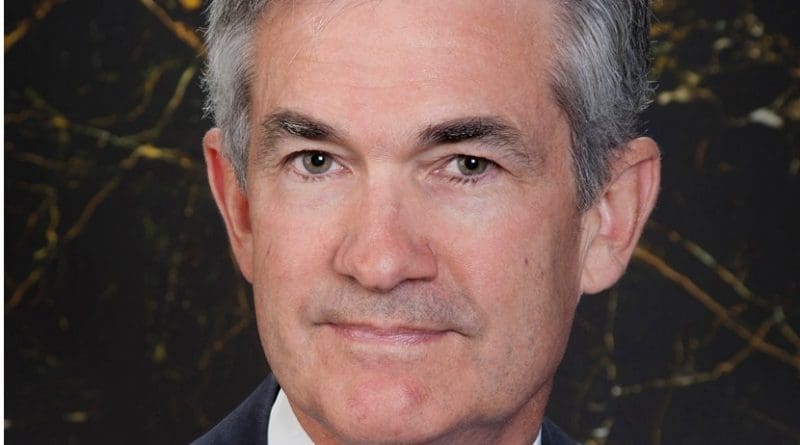As The Fed’s Powell Continues To Flail, Could An MMT Fed Chair Be Next? – OpEd
By MISES
By Tho Bishop*
Inflation in America continues to rise, and with it skepticism in Federal Reserve chairman Jay Powell’s insistence that increased prices are “transitory.” This double whammy of consumer pain and declining institutional confidence increases the odds of another challenge to the Fed’s current plans: a change in leadership.
To date, there has been no indication from either Kamala Harris or Joe Biden that Jay Powell is likely to end up cashing his own covid-boosted unemployment benefits. While a political party losing control of the executive branch typically means a pink slip for most of the predecessors’ chosen policymakers, Fed chairs have historically had a knack for sticking around.
In 1983, Ronald Reagan renominated Jimmy Carter’s Fed selection—Paul Volker—before appointing Alan Greenspan to the Fed in 1987. While 90s American politics was marked by escalating personal and partisan spats between Republicans and Democrats, Greenspan cemented his spot as one of the most powerful men in the world with the support of both George H.W. Bush and Bill Clinton. Even Ben Bernanke, the first Fed chair to be the subject of a new generation of well deserved—and often hilarious—online ridicule received the support of both George W. Bush and Barack Obama.
Romantics would argue this is an illustration of the central banks’ cherished—and mythical—“independence”; cynics would point out that it reflects a bipartisan commitment to credit expansion and easy money. Even Trump, who campaigned on a surprisingly strong grasp on the consequences of the Fed’s monetary hedonism, ended up selecting an Obama-appointed Fed governor for the position.
Of course, there is an additional reason for hesitancy in changing the name on the stationary at the Eccles Building: regime certainty. In 2009, for example, the conventional wisdom of DC and Wall Street was that a disruption in the Fed’s leadership would undermine America’s already anemic recovery from the recent financial crises.
For similar reasons, Politico has reported that a second term for Jay Powell is “his to lose.” Also supporting his case is the degree to which his views on the economy have mirrored that of his predecessor turned Treasury secretary, Janet Yellen.
There is a lot of time, however, between now and the end of his term in 2022.
While Fed chairs in the past have been renominated in the face of weak economic growth and underperforming labor markets, the political calculation of maintaining the status quo is very different in a country feeling the daily pain of rising consumer prices. The more the Fed admits inflation will last longer than expected, the more we are likely to see betting markets lose faith in the return of Chairman Powell.
What would a post-Powell Fed look like? That is where things get interesting.
As illustrated above, a change in personnel in the Fed in recent years has not meant a radical change in policy. As such, the heir-apparent would be a dependable, status quo partisan like Lael Brainard—an Obama-appointed Fed governor who was a finalist to be the current Treasury secretary.
There is, however, growing interest on the progressive left in the work of Stephanie Kelton and other advocates of modern monetary theory. Additionally, the great political advantage of MMT—like Keynesianism in the 1930s—is that it provides an intellectual veneer for a political left that believes the biggest problem with American economic policy is its frugality. Kelton has publicly advocated for the Biden administration to rely on the Fed—rather than taxes—to support aggressive increases in federal spending.
The enthusiasm for MMT is not shared by Ms. Brainard, nor any of the other obvious candidates within the existing Fed. Neel Kashkarki, for example, head of the Minneapolis Fed and one of the more dovish voices in the central bank, has been a strong critic of Kelton’s work. Could progressive pressure, mixed with escalating economic pressure, push White House decision-makers to embrace a radical, outside the box choice to lead the Fed?
The previous administration was gifted an opportunity to significantly reshape the ideology of the Fed thanks to multiple potential openings on the Federal Reserve Board of Governors. While some interesting nominees were considered, the status quo won out.
With multiple vacancies on the horizon in 2022, that may not be the case for much longer.
*About the author: Tho is an assistant editor for the Mises Wire, and can assist with questions from the press. Prior to working for the Mises Institute, he served as Deputy Communications Director for the House Financial Services Committee. His articles have been featured in The Federalist, the Daily Caller, and Business Insider.
Source: This article was published by the MISES Institute

